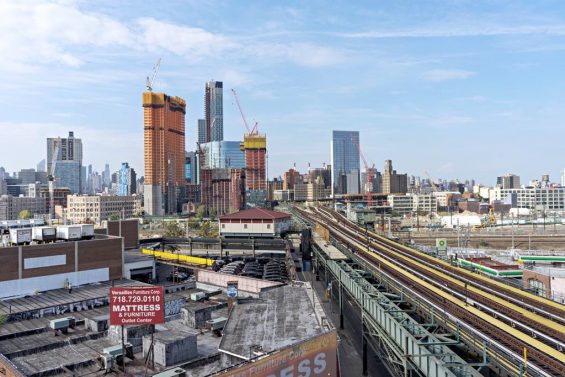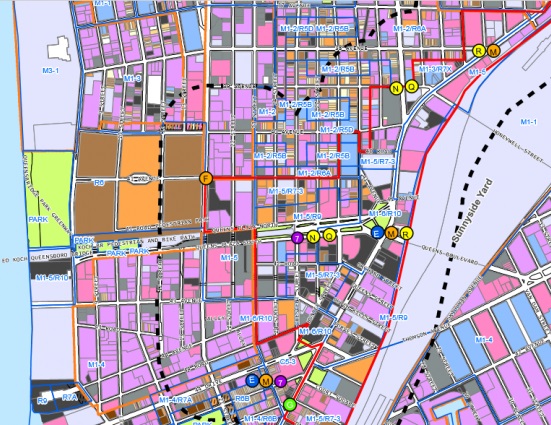April 1, 2019 By Alexa Beyer
Many New Yorkers claim that neighborhood rezonings lead to the displacement of existing residents–yet have lacked data to back-up their assertion.
Queens City Council Member Francisco Moya introduced legislation last week that aims to provide such data. His bill calls for the city to study the effect of each neighborhood rezoning and to see whether area residents are in fact displaced.
“With every neighborhood-wide rezoning, the future for thousands and thousands of New Yorkers are thrown into uncertainty,” Moya said. “Unfortunately for their residents, we can’t tell them exactly how a neighborhood rezoning will affect gentrification or secondary displacement because we have absolutely no quantitative data to offer them.”
The bill, Int.1487, would require that every neighborhood rezoned after Jan. 1, 2015 be studied five years after, meaning that the first of such studies would take place in 2020.
From each rezoning’s five-year mark, the city would have six months to conduct the study and report its findings to City Council.
If enacted, Moya’s bill would equip residents slated for neighborhood-wide rezonings with data on how other communities were affected.
“Good data inspires good policy and if we’re going to overcome this city’s housing crisis, we’ll need both,” Moya said.
The Queens Plaza/Court Square area is one of 15 neighborhoods that Mayor Bill de Blasio said in 2015 he would like to see rezoned. Several neighborhoods on that list have since been rezoned such as Inwood, East New York and East Harlem.
In 2017, the Department of City Planning started studying a 50-block section of Queens Plaza/Court Square—as part of the LIC Core Study–which was to be the precursor for a rezoning.
Many Long Island City residents have been skeptical of the prospect, though, citing a 2001 rezoning of the same Queens Plaza/Court Square area that sought to turn the area into a vibrant business district but instead resulted in a luxury tower boom.
Although the city says that the new rezoning would seek to correct the unintended consequences from 2001, some residents fear that it would instead accelerate gentrification and price existing residents and business owners out.
Although plans for Long Island City have yet to move forward, if the city were to try to move ahead next year or any time after, residents may have access to the earliest studies spurred by the bill.
“Neighborhood-wide rezonings are sold as efforts to increase our stock of affordable housing, but, if we look at where these massive rezonings are being applied, all too often we see lower-income New Yorkers of color being displaced from their communities,” said Javier H. Valdés, Co-Executive Director of Make the Road NY.
“We deserve to know how these neighborhood rezonings have affected residents, specifically the type of residents these rezonings purport to benefit, as they continue to reshape our city.”
The city does try to estimate the amount of secondary displacement a rezoning is likely to trigger as part of the City Environmental Quality Review (CEQR) process before it is approved.
However, studies resulting from Moya’s bill would allow the city to compare a rezoning’s original estimated secondary displacement figure with the actual amount of secondary displacement it caused.
If a study finds five percent or more secondary displacement than the original CEQR estimate, it would recommend improvements to the CEQR manual to more accurately estimate displacement in the future.
Moya, who represents Corona, East Elmhurst and LeFrak City and chairs the Subcommittee on Zoning and Franchises, has four co-sponsors for his bill.
8 Comments









If you don’t own and can’t afford to live in an area anymore it’s time to move. What could be more simple.
It is worth reading Zoned Out! Race, Displacement, and City Planning in NYC by Angotti and Morse.
The “displacement” rhetoric is very subjective. Once upon a time Corona was full of italians. Does that mean they were displaced by latinos? East Elmhurst was full of african americans, does that mean they were displaced by latinos? Jackson Heights was full of white people, does that mean they were displaced by latinos? Of course not, neighborhood changes is part of the natural evolution of New York. In other words, there is no such thing as displacement
“Rico Suave” Your point about neighborhood changes being part of the natural evolution of New York correct. However, your labels for these “Once upon a time(s)” are not.
The actual changes are:
Corona was full of Italians, they are being displaced by ̶l̶a̶t̶i̶n̶o̶s̶?̶ illegals.
East Elmhurst was full of African Americans, they are being displaced by ̶l̶a̶t̶i̶n̶o̶s̶?̶ illegals.
Jackson Heights was full of “white people”, They are being displaced by ̶l̶a̶t̶i̶n̶o̶s̶?̶ illegals.
They weren’t displaced, they chose to move to better neighborhoods or leave Queens altogether once the Latinos started arriving in masses.
Thankfully Jackson Heights is largely made up of co-ops so the neighborhood isn’t completely in danger of becoming the next Corona.
“all too often we see lower-income New Yorkers of color being displaced from their communities”
– this is a false statement, the lower income population is FIRMLY embedded in Corona/Elmhurst/East Elmhurst/parts of Jackson Heights…they aren’t going anywhere
Do you check under your bed at night for Latinos?
Whoa, ANOTHER feeble ad hominem retort by the Defender of Illegal Aliens.
I was addressing how illogical JS resident’s rants about immigrants are.
You can google “argumentum ad hominem” if you want to learn what is actually is instead of just regurgitating stuff you read on the internet without understanding it.